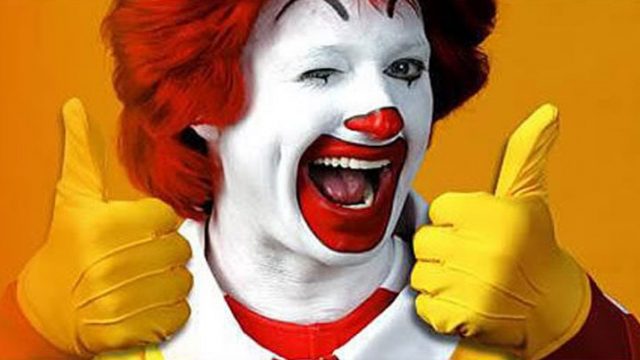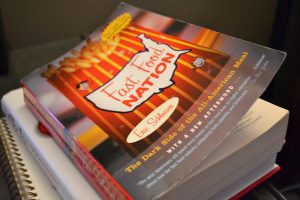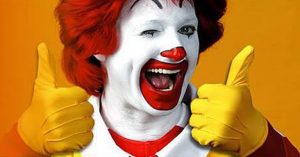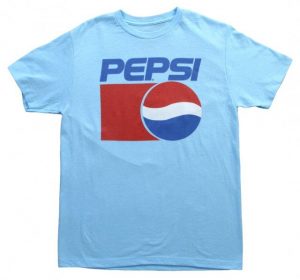My parents were anti-fast food when I was growing up, and as a result I can count on one hand the number of times one or both treated me to it. I occasionally ate fast food school outings or with friends. In my early teens I became a health nut, and besides a short-lived infatuation earlier this year with the delicious chicken biscuits at Chick-Fil-A (damn, that shit is good…) that I gave up cold turkey when the employees at the one near me started greeting me by name and knew my order before I gave it, I’ve mostly avoided fast food as an adult.
I also avoided reading Eric Schlosser’s Fast Food Nation: The Dark Side of the All-American Meal for a long time because it seemed irrelevant to me, like it was “preaching to the choir,” and, also because I don’t really care for advocacy books. After being recommended the book multiple times by multiple people, I gave it a shot and discovered something completely different than what I expected. I thought that Fast Food Nation was nothing but a screed against the evils of fast food, and at times it is, but it’s also so much more.
Published on Jan 17, 2001, the book has its roots in a 1998 two-part article, also by Schlosser, and, also called Fast Food Nation for Rolling Stone magazine, that’s available online.
The first part of the book, “The American Way” tells the story of the history of fast food in post-World War II America, from humble burger stands to major corporations, focusing on Ray Kroc, of course. Schlosser weaves Kroc’s story with that of Walt Disney, whom Kroc was obsessed with, and whom also took a small business into a powerhouse in part thanks to their successful use of what’s now known as “synergy.” “The American Way” is the perfect title because their stories are uniquely American.
The second part, “Meat and Potatoes” concentrates on the production of fast food from farms to your lunch bag. It covers everything from the sexually harassment and abuse that is almost routine for women working in slaughterhouses to the teenagers getting up at 5am to open at a suburban restaurant.
What really makes the book truly great is that it explores the multitude of reasons that fast food is appealing to so many people, from its low-cost, to its convenience, to the additives that make it more appealing, and especially how it tastes. Chapter 5, “Why the Fries Taste Good” follows the production of McDonald’s french fries starting with them being harvested and ending with a mouthwatering paragraph where Schlosser describes in almost pornographic fashion eating them,
“Every half hour, a new batch of fries was cooked in fryers identical to those used in fast food kitchens. A middle-aged woman in a lab coat handed me a paper plate full of premium extra longs, the type of french fries sold at McDonald’s, and a salt shaker, and some ketchup. The fries on the plate looked wildly out of place in this laboratory setting, this surreal food factory with its computer screens, digital readouts, shiny steel platforms, and evacuation plans in case of ammonia gas leaks. The french fries were delicious – crisp and golden brown, made from potatoes that had been in the ground that morning. I finished them and asked for more.”
The most headshaking aspect of the book to me isn’t the parts about underpaid workers or horrible nutrition, but about how fast food companies, particularly McDonald’s, use marketing. In the chapter titled “Your Trusted Friends,” which describes this marketing, a McDonald’s executive discusses a line of videos “starring” Ronald McDonald called The Wacky Adventures of Ronald McDonald is quoted as saying, “We see this as a great opportunity to create a more meaningful relationship between Ronald and kids.”
I swear, the first time I read that I yelled, “WHAT IN THE EVERLOVING FUCK?” Really, What in the everloving fuck? Who the fuck wants their children to have a “meaningful relationship” with a fast food mascot?
Another troubling thing Fast Food Nation illustrates is how ingrained junk food companies are in our culture thanks to corporate sponsorship. The highlight of this section is the story of a senior Greenbrier High School in Evans, Georgia, who when his school held a “Coke in Education Day,” a day that Schlosser describes thusly, “and a dozen Coca-Cola executives had come for the occasion. Greenbrier High was hoping for a $500 prize, which had been offered to the local high school that came up with the best marketing plan for Coca-Cola discount cards. As part of the festivities, Coke executives had lectured the students on economics and helped them bake a Coca-Cola cake,” decided to wear a Pepsi shirt. He was suspended for a week, though after media attention, was allowed to return to school after a single day.
I like that “Coke in Education Day” didn’t guarantee that Greenbrier High get the $500, but was competing with other schools for a chance to win it. I’m pretty sure that running high school for a day cost significantly more than $500, so even if that had won, they wouldn’t even recoup the expenses of the day they lost to Coke.
The chapter “The Most Dangerous Job” explores the frightening amount of violence that occurs in fast food restaurants. In 1998 alone, more restaurant workers were murdered on the job in the United States than police officers. Owing to their long hours, young and/or undocumented staff, and lack of security, fast food places are a favorite target of robbers.
In the 17 years since Fast Food Nation: The Dark Side of the American Meal was published, it has only become more relevant. Schlosser’s ranting about the corporate culture of McDonald’s doesn’t sound much different than Bernie Sanders’ tirades about the corporate culture that now seems part of every aspect of society,
“During the past two decades, rhetoric about the ‘free market’ has cloaked changes in the nation’s economy that bear little relation to real competition or freedom of choice. From the airline industry to the publishing business, from the railroads to telecommunications, American corporations have worked hard to avoid the rigors of the market by eliminating and absorbing their rivals…
The history of the twentieth century was dominated by the struggle against totalitarian systems of state power. The twenty-first will no doubt be marked by a struggle to curtail excessive corporate power. The great challenge now facing countries throughout the world is how to find a proper balance between the efficiency and the amorality of the market. Over the past twenty years the United States has swung too far in one direction, weakening the regulations that safeguard workers, consumers, and the environment. An economic system promising freedom has too often become a means of denying it, as the narrow dictates of the market gain precedence over more important democratic values.
Today’s fast food industry is the culmination of those larger social and economic trends. The low price of a fast food hamburger does not reflect its real cost – and should. The profits of the fast food chains have been made possible by losses imposed on the rest of society.”
Miscellaneous:
-Despite containing no narrative arc, Fast Food Nation was adapted into a feature film in 2006.
-The book is regularly assigned in high school and college courses devoted to a multitude of subjects including, but not limited to; nutrition, sociology and marketing.
-Willard Scott was the original Ronald McDonald, he even came up with the name, at a franchise in Washington D.C. However, when McDonald’s decided to replace him because according to the book, “he was deemed too overweight; McDonald’s wanted someone thinner to sell its burgers, shakes, and fries.”
-The nutrition content of fast food, or lack thereof, got the shortshift in my article. It doesn’t in the book. I didn’t want to talk about it, since there are an enormous number of books on how bad fast food is for people, I decided to focus on the more unique aspects of Fast Food Nation.
-Schlosser, along with journalist Charles Wilson, adapted the book into a “kid friendly” version aimed at middle school aged children called Chew on This. I’ve read it, and it focuses almost entirely on nutrition. The “scary” parts with sexual harassment and slaughterhouses have been redacted entierly.
-Internet reviewer Alison Pregler reviews one of the movies with Ronald McDonald, Visitors from Outer Space as the main character from Subspecies, Radu. Radu is as horrified by Ronald as I am.






